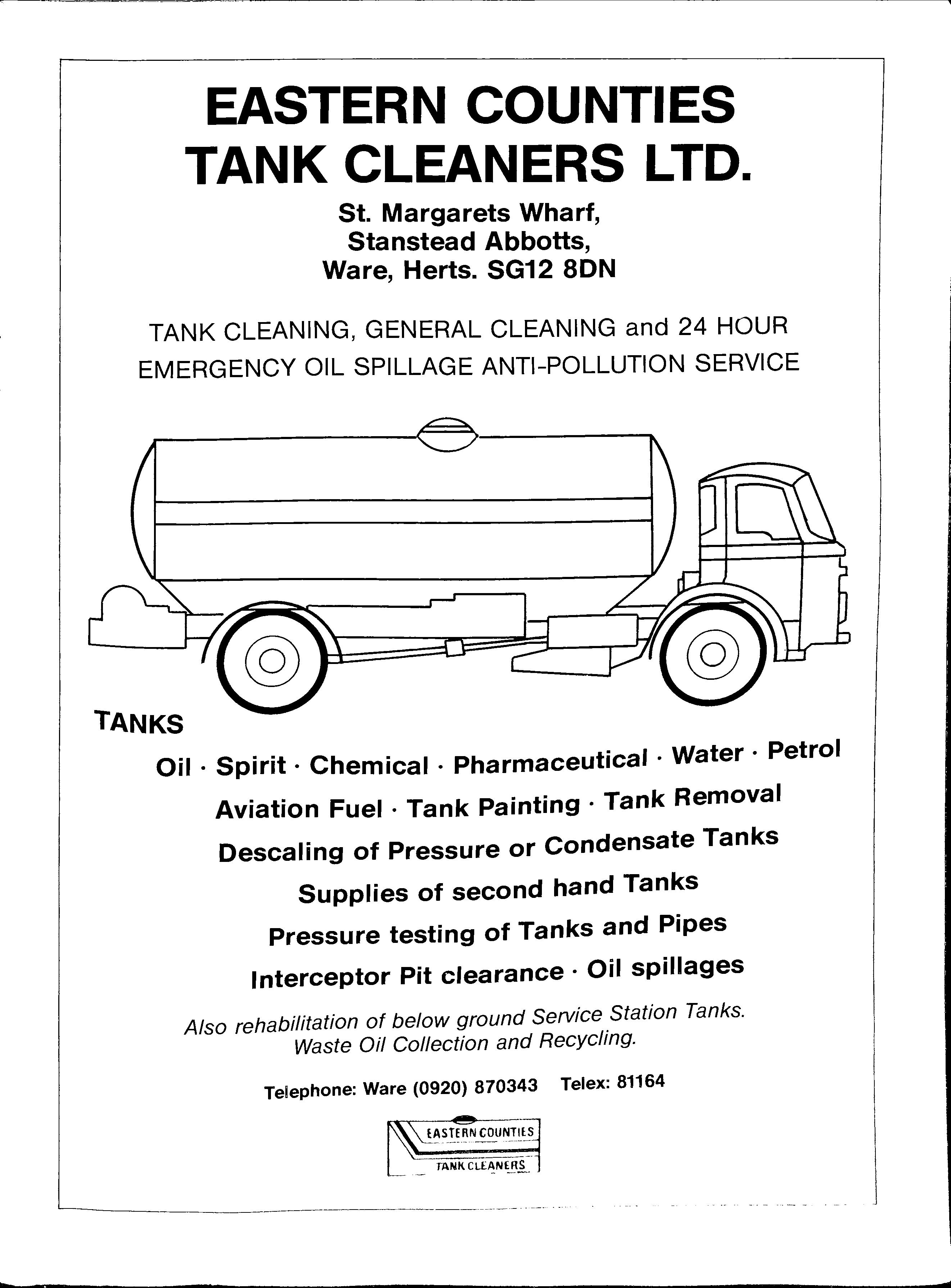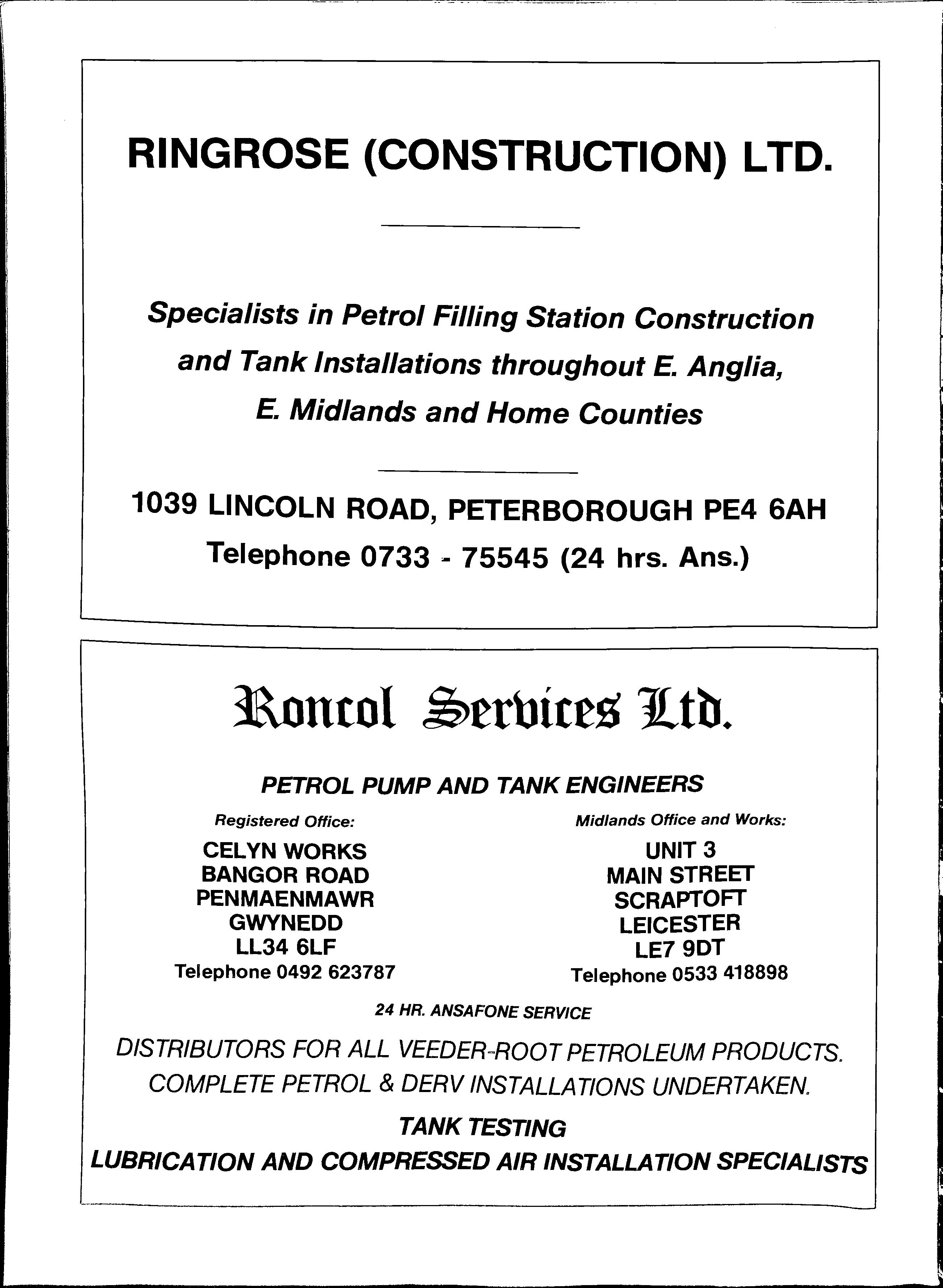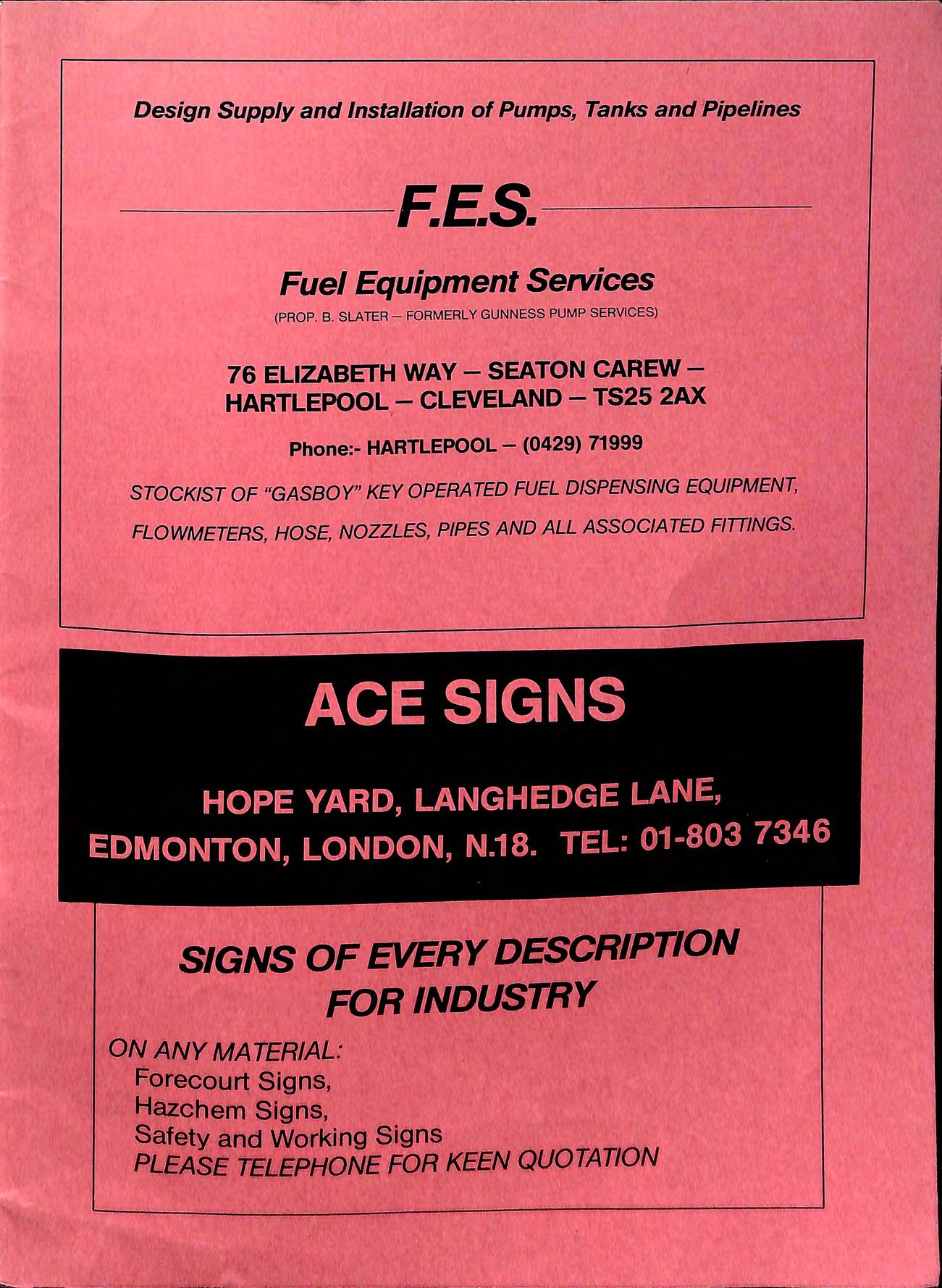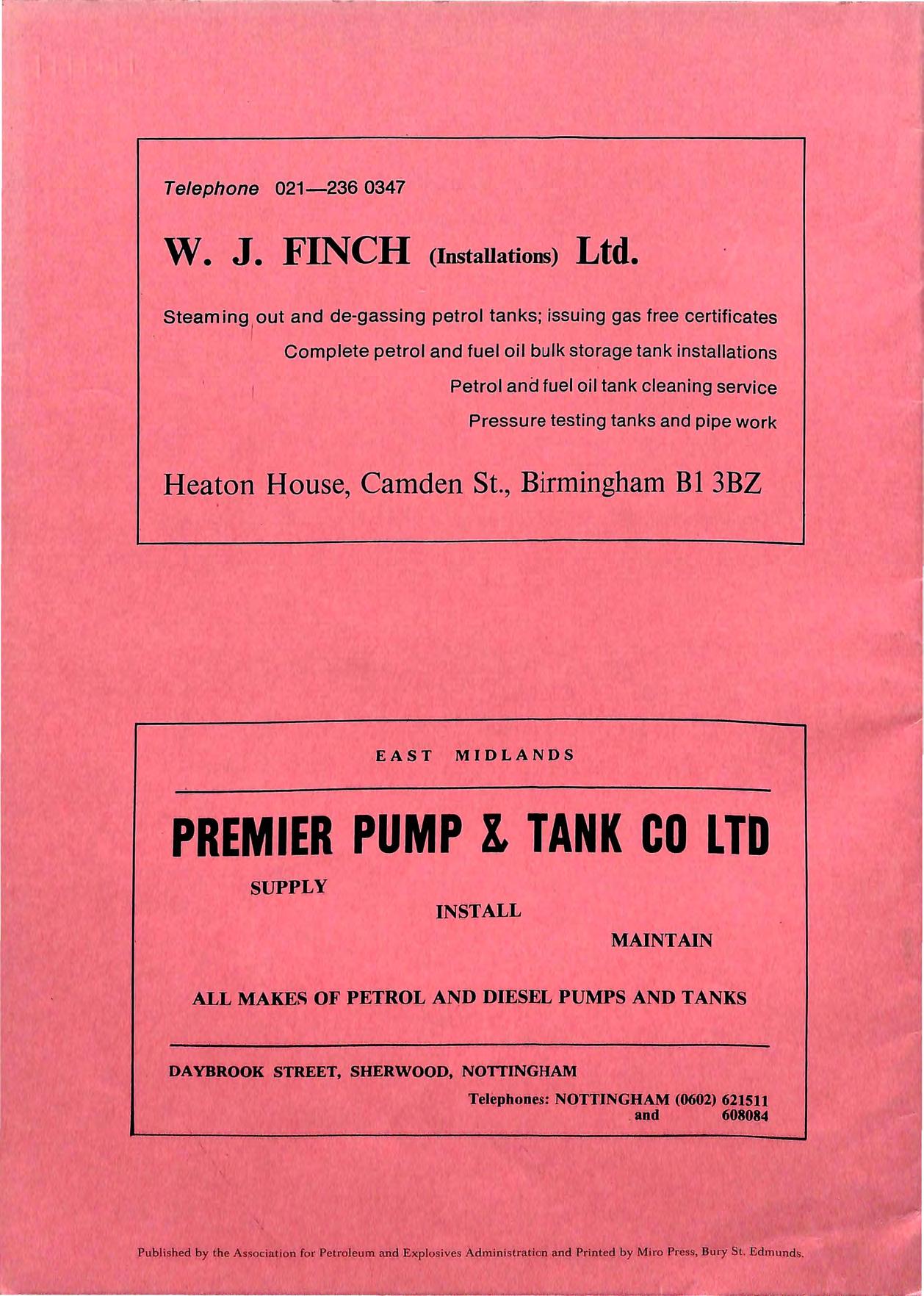Journal of the Association for Petroleum and Explosives Administration


"THE INDEPENDENT FUEL"




Journal of the Association for Petroleum and Explosives Administration





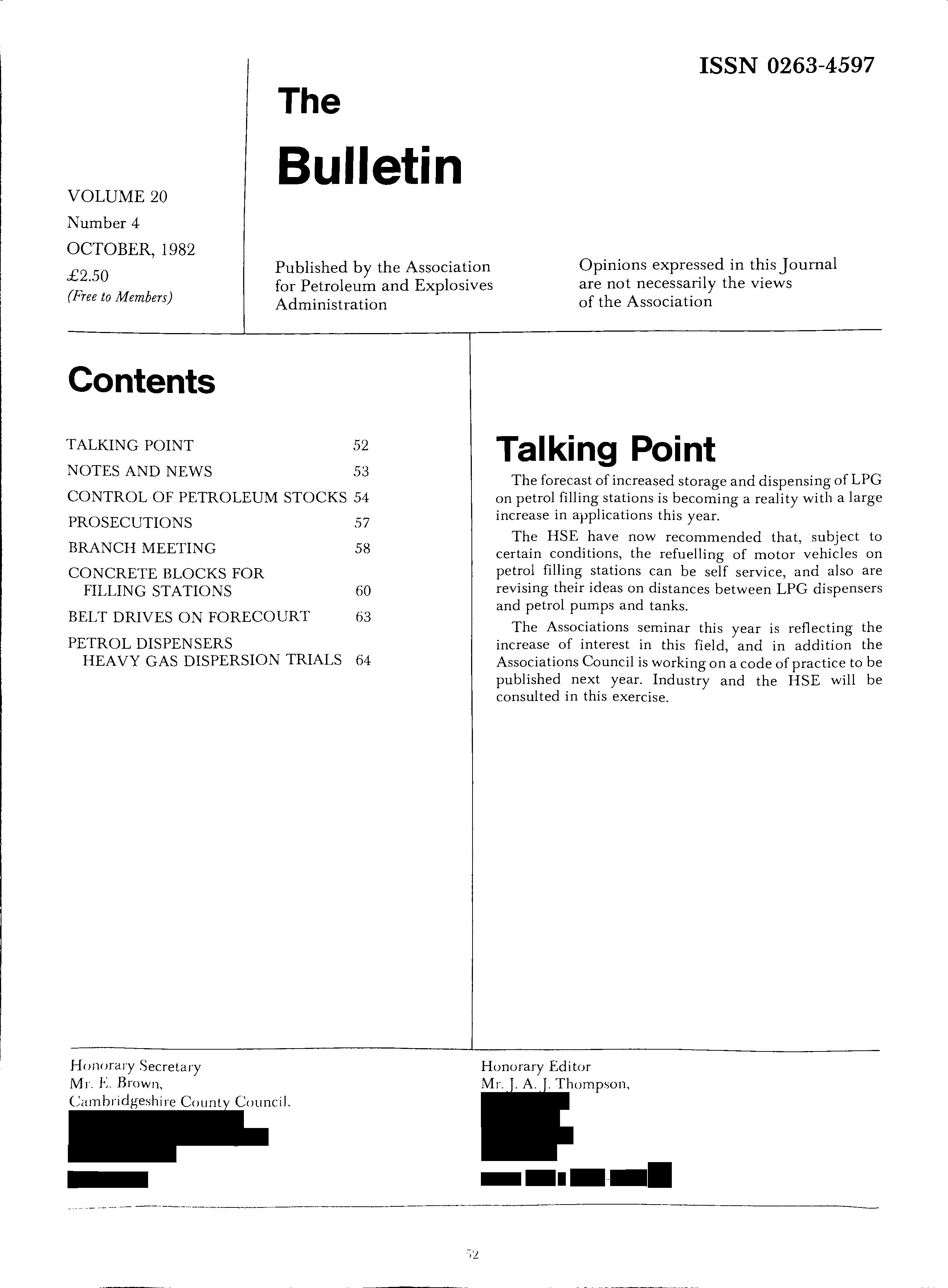
VOLUME 20
Number 4
OCTOBER, 1982 £2.50 (Free to Members)
Published by the Association for Petroleum and Explosives Administration
Opinions expressed in this Joumal are not necessarily the views of the Association
TALKING POINT 52
NOTES AND NEWS 53
CONTROL OF PETROLEUM STOCKS 54
PROSECUTIONS 57
BRANCH MEETING 58
CONCRETE BLOCKS FOR FILLING STATIONS 60
BELT DRIVES ON FORECOURT 63
PETROL DISPENSERS HEAVY GAS DISPERSION TRIALS 64
The forecast of increased storage and dispensing of LPG on petrol filling stations is becoming a reality with a large increase in applications this year.
The HSE have now recommended that, subject to certain conditions, the refuelling of motor vehicles on petrol filling stations can be self service, and also are revising their ideas on distances between LPG dispensers and petrol pumps and tanks.
The Associations seminar this year is reflecting the increase of interest in this field, and in addition the Associations Council is working on a code of practice to be published next year. Industry and the HSE will be consulted in this exercise.
Honorary Secretary M r. E. Brown, Cambridgeshire County Council,
A student died after being caught in a fire while apparently trying to relieve his piles with petrol an inquest at St. Pancras in London heard recently. Norik Hakpioan of Sloane Terrace Kensington was found naked with 90 per cent bums on his body. The vapour from the open bottle of petrol had been ignited by a nearby cooker hotplate.
His brother said that relieving piles with paraffin was an old family remedy, and it was thought in this case petrol had been used.
The coroner Dr Missen recorded a misadventure verdict and added that it must be "the most lethal treatment recorded for many years".
following general comments apply equally to repaIrs, e.g. motor rewinds, and to maintenance, e.g. lamp replacement in a lighting fitting.
The first stage in a series of new controls over industrial sites. and certain pipelines handling major quantities of particular hazardous substances will come into force on 1 January next year.
follows the laying before Parliament today by Mr. Davld Waddington, Under Secretary of State for Employment, of the Notification of Installations Handling Hazardous Substances Regulations.
, The .re?,ulations, drawn up by the Health and Safety Co.mmlsslOn, follow consultation with industry, trade UnIons, local authorities and government departments. The substances covered, such as LPG, chlorine carbon disulphide, ethylene oxide and sodium chlorate 'and the quantities involved, are listed in a schedule at the end of the regulations. From 1 January 1983 anyone in control of notifiable sites or pipelines must provide details of their activities to the Health and Safety Executive and report any change in their operations if it affects the original notification. If the level of any substance on site is increased to three times the originally notified figure, renotification to HSE is required.
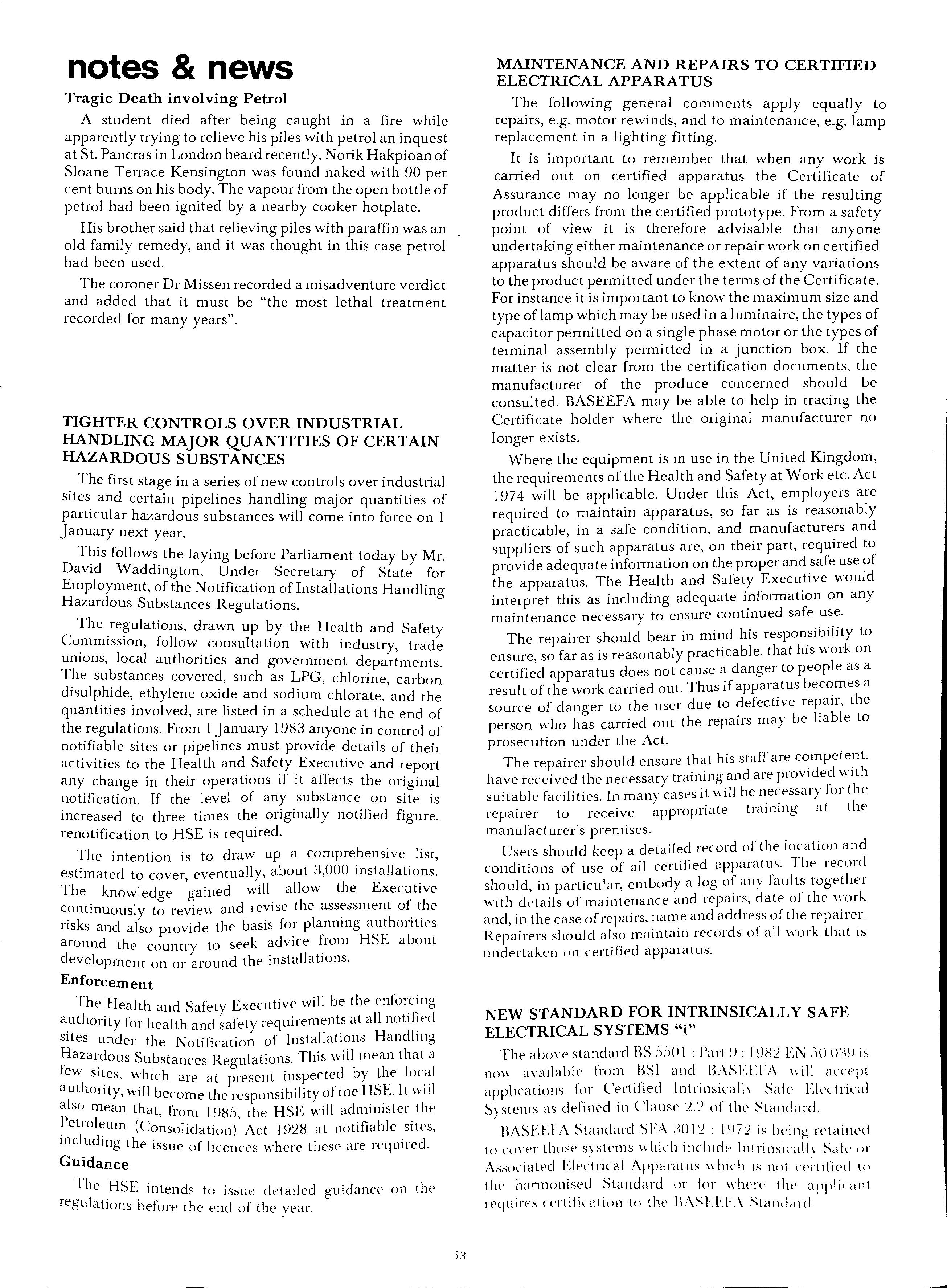
The intention is to draw up a comprehensive list, estimated to cover, eventually, about :-3,000 installations. The knowledge gained will allow the Executive continuously to review and revise the assessment of the risks and also provide the basis for planning authorities around the country to seek advice from HSE about development on or around the installations.
The .Health and Safety Executive will be the a.uthonty for health and safety requirements at all notified sites under the Notification of Installations Handling Hazardous Substances Regulations. This will mean that a few which are at present inspected by the local authonty, will become the responsibility ofthe HSE. It will also mean that, from 198.'>, the HSE administer the Petroleum (C I'd 'f' bl . I' ·onso I ation) Act 19:18 at notl la e Sites, me udmg the . f . . d Issue 0 lIcences where these are require Guidance
The HSE intends to issue detailed guidance on the regulations before the end of the year.
It is important to remember that when any work is carried out on certified apparatus the Certificate of Assurance may no longer be applicable if the resulting product differs from the certified prototype. From a safety point of view it is therefore advisable that anyone undertaking either maintenance or repair work on certified apparatus should be aware of the extent of any variations to the product permitted under the terms of the Certificate. For instance it is important to know the maximum size and type oflamp which may be used in a luminaire, the types of capacitor permitted on a single phase motor or the types of terminal assembly permitted in a junction box. If the matter is not clear from the certification documents, the manufacturer of the produce concerned should be consulted. BASEEFA may be able to help in tracing the Certificate holder where the original manufacturer no longer exists.
Where the equipment is in use in the United Kingdom, the requirements of the Heal th and Safety at Work etc. Act 1974 will be applicable. Under this Act, employers are required to maintain apparatus, so far as is reasonably practicable, in a safe condition, and manufacturers and suppliers of such apparatus are, on their part, required to provide adequate information on the proper and safe use of the apparatus. The Health and Safety Executive would interpret this as including adequate information on any maintenance necessary to ensure continued safe use.
The repairer should bear in mind his responsibility to ensure, so far as is reasonably practicable, that his "vork on certified apparatus does not cause a danger to people as a resul t of the work carried out. Thus if apparatus becomes a source of danger to the user due to defective repair, the person who has carried out the repairs may be liable to prosecution under the Act.
The repairer should ensure that his staff are have received the necessary training and are proVided With suitable facilities. In many cases it will be necessary for the repairer to receive appropriate training at the manufacturer's premises.
Users should keep a detailed record of the location and conditions of use of all certified apparatus. The record should, in particular, embody a log of any faults together with details of maintenance and repairs, date of the work and, in the case of repairs, name and address of the repairer. Repairers should also maintain records of all work that is undertaken on certified apparatus.
The above standard BS 550 I : Part : I EN :)0 is now available from BSI and BASEEI-'A "'ill arcppt applications for Certified Intrinsicalh Safe- Electrical Systems as defined in Clause '2.'1. of tlw Standard.
BASEEFA Standard SFA :·Hll'1. : is Lwing retained to cover those systems "hich inrlude Intrinsical" Safe 1lI Associatpd Electrical Apparatus "hid1 is nut l"t';·tifit'ci It) the harmonised Standard or for "Iwre tht' applicant rpquires certification to the BASEEF.\ Standard
Bedfordshire Trading Standards Department has recently received a complaint that a two-gallon petrol can (metal) had discarded the plastic-threaded filler cap, with the result that petroleum spirit and vapour had escaped into the car. Due to an internal build up of pressure within the petrol can.
It has been alleged that the petrol can had been left in the rear of a hatchback Ford Escort which did not have the rear cover in position. The car had been left in a car park on a hot sunny day for approximately four hours.
On returning to the vehicle the complainant found the plastic cap on the front seat and evidence of liquid petrol contamination. A box of 10 cassette tape covers had been fused together.
In addition to the very strong petrol vapours within the car, it was noted that the instrument panel glass had also misted over and liquid spots of petrol were found on top of the dash panel.
I have information of similar incidents in Berkshire and Buckinghamshire. However, I would be grateful if any other authority having knowledge of any similar incident would please contact me on
B. D. TaylorBedfordshire
Trading Standards Dept.
The regular and accurate control of petroleum stocks by and petrol stations is essential, firstly to comply WIth the conditions of Licence and Legislation and secondly with the high cost of fuel an operator cannot afford to lose stocks.
With modern equipment and efficient supervision and controls dip losses should not exceed of sales volume. Any loss in excess of this should be investigated and the reason identified. Methods of control fall in to three ('ategories:
I. Daily dips and reconciliation.
1-. Independant clips done weekly.
; , ank!'r Delivery control.
Daily stock dips and comparison with book stocks will show any tank variances as shown in figure one, these figures are prepared each morning by the site or forecourt Manager having worked out the previous days sales and receipts. Any large discrepency should immediately be reported to the Supervisor or Head Office.
An idependant dip and full reconciliation of sales, deliveries and stocks should be done on a weekly basis over a period of a month of four or five weeks. Each sheet will show total useage for the period and tank variances, the result is expressed as a percentage of Throughput. This can clearly be seen from the example shown in figure two
The Association welcomes the following new membersP. WilIett, Tarranden, J. J. O'Kane, D. A. Brown, A. J. Polden, G. E. Neale, P. R. Taylor, Chiltern Glass Fibres Ltd Edward R. Faultless, Miss A. Andrews,
All the examples shown have been restricted to a site having two pumps {one blender, one mono} and two tanks {one premium, one regular}, all figures are quoted in gallons. In practice provision is made for up to eight pumps and eight tanks in addition to paraffin and derv. Exactly the same procedure is used if records are in litres. Percentage loss can be worked out on any individual tank.
Tanker delivery control sheet {see below} must be checked and reconciled.
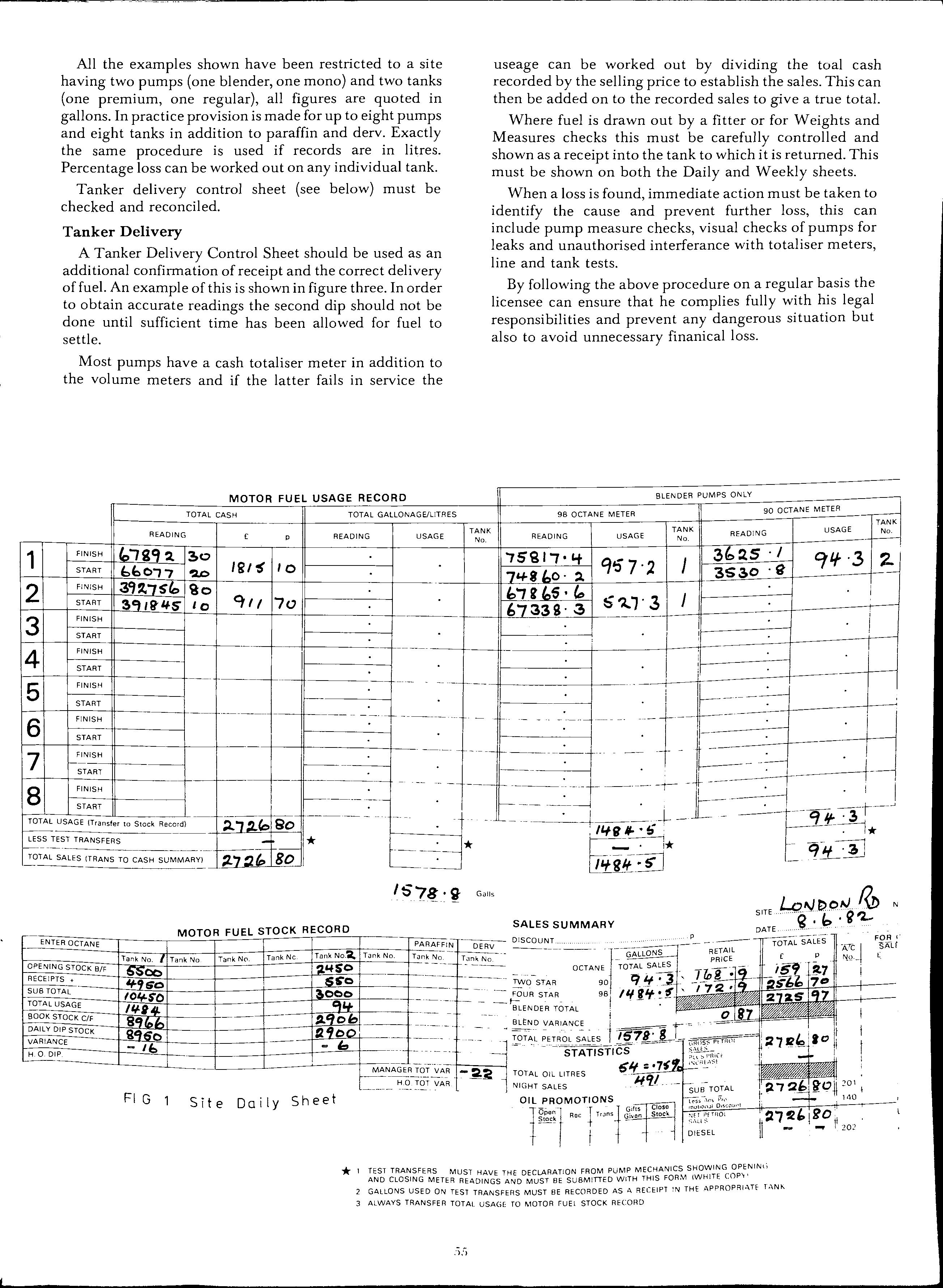
A Tanker Delivery Control Sheet should be used as an additional confirmation of receipt and the correct delivery of fuel. An example of this is shown in figure three. In order to obtain accurate readings the second dip should not be done until sufficient time has been allowed for fuel to settle.
Most pumps have a cash totaliser meter in addition to the volume meters and if the latter fails in service the
useage can be worked out by dividing the toal cash recorded by the selling price to establish the sales. This can then be added on to the recorded sales to give a true total.
Where fuel is drawn out by a fitter or for Weights and Measures checks this must be carefully controlled and shown as a receipt into the tank to which it is returned. This must be shown on both the Daily and Weekly sheets.
When a loss is found, immediate action must be taken to identify the cause and prevent further loss, this can include pump measure checks, visual checks of pumps for leaks and unauthorised interferance with totaliser meters, line and tank tests.
By following the above procedure on a regular basis the licensee can ensure that he complies fully with his legal responsibilities and prevent any dangerous situation but also to avoid unnecessary finanical loss.
MOTOR FUEL USAGE RECORD TDTAL CASH TDTAL GALLONAGE/LITRES
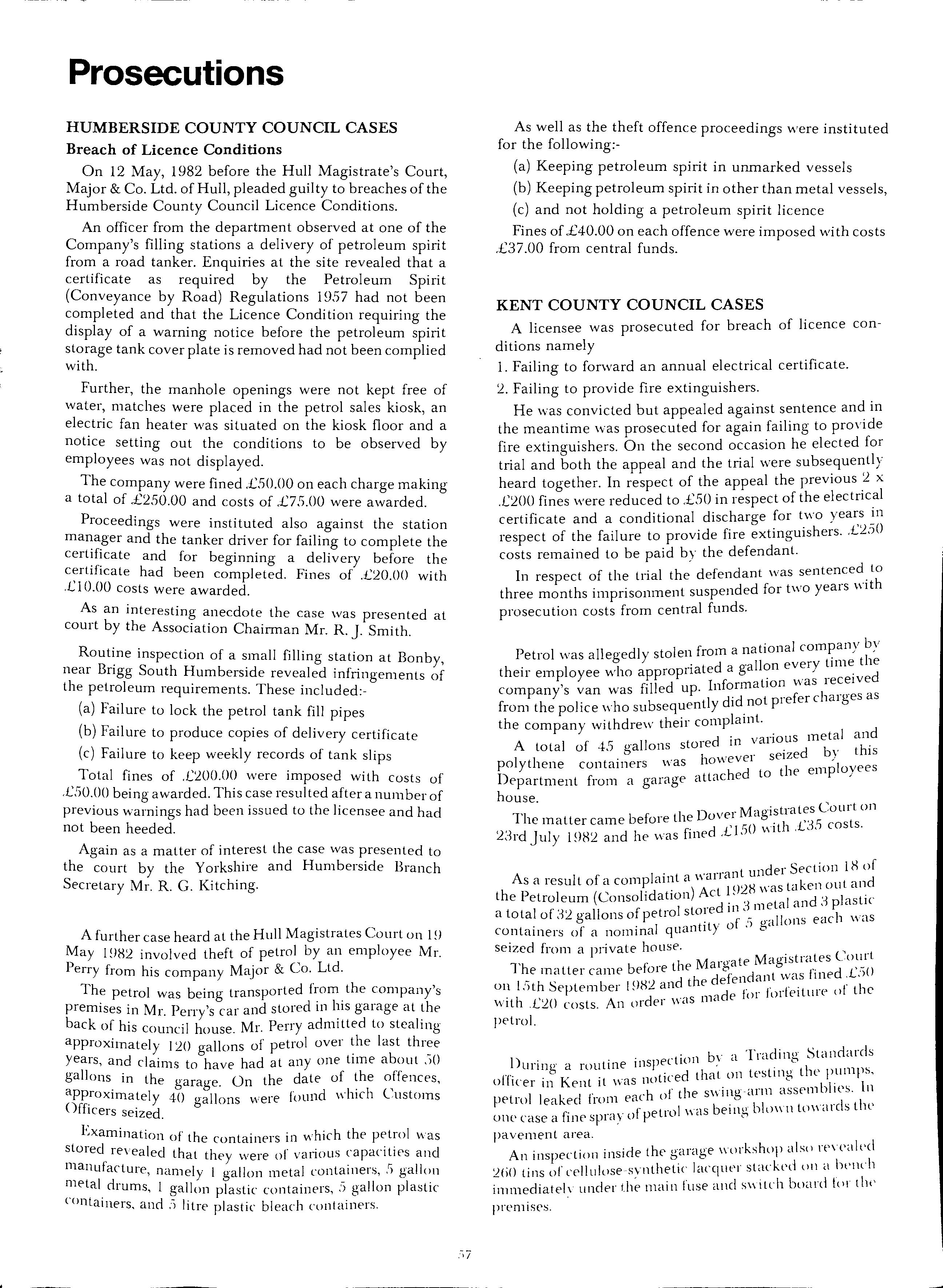
On 12 May, 1982 before the Hull Magistrate's Court, Major & Co. Ltd. of Hull, pleaded guilty to breaches of the Humberside County Council Licence Conditions.
An officer from the department observed at one of the Company's filling stations a delivery of petroleum spirit from a road tanker. Enquiries at the site revealed that a certificate as required by the Petroleum Spirit (Conveyance by Road) Regulations 1957 had not been completed and that the Licence Condition requiring the display of a warning notice before the petroleum spirit storage tank cover plate is removed had not been complied with.
Further, the manhole openings were not kept free of water, matches were placed in the petrol sales kiosk, an electric fan heater was situated on the kiosk floor and a notice setting out the conditions to be observed by employees was not displayed.
The company were fined £50.00 on each charge making a total of £250.00 and costs of £75.00 were awarded.
Proceedings were instituted also against the station and the tanker driver for failing to complete the and for beginning a delivery before the certificate had been completed. Fines of .£20.00 with £ 10.00 costs were awarded.
As an interesting anecdote the case was presented at court by the Association Chairman Mr. R. J. Smith.
inspection of a small filling station at Bonby, near Bngg South Humberside revealed infringements of the petroleum requirements. These included:-
(a) Failure to lock the petrol tank fill pipes
(b) Failure to produce copies of delivery certificate
(c) Failure to keep weekly records of tank slips
Total fines of £200.00 were imposed with costs of £50.00 being awarded. This case resul ted after anum ber of previous warnings had been issued to the licensee and had not been heeded.
Again as a matter of interest the case was presented to the court by the Yorkshire and Humberside Branch Secretary Mr. R. G. Ki tching.
A further case heard at the Hull Magistrates Court on I!) May 19H2 involved theft of petrol by an employee Mr. Perry from his company Major & Co. Ltd.
The petrol was being transported the company's premises in Mr. Perry's car and stored m garage at back of his council house. Mr. Perry admitted to steall11g approximately 120 gallons of petrol over last years, and claims to have had at anyone tllne about ,)0 gallons. in the garage. On the date of o,ffences, app.roxlmately 40 gallons were found winch Customs Officers seized.
Examination of the containers in which the petrol 'Nas stored, revealed that they were of vaIiolls capacities and manufacture, namely I gallon metal containers, oS gallon metal drums, I gallon plastic containers, S gallon plastic COntainers, and :i litre plastic bleach containers.
As well as the theft offence proceedings were instituted for the following:-
(a) Keeping petroleum spirit in unmarked vessels
(b) Keeping petroleum spiri t in other than metal vessels, (c) and not holding a petroleum spirit licence
Fines of £40.00 on each offence were imposed with costs £37.00 from central funds.
A licensee was prosecuted for breach of licence conditions namely
1. Failing to forward an annual electrical certificate. 2. Failing to provide fire extinguishers.
He was convicted but appealed against sentence and in the meantime was prosecuted for again failing to provide fire extinguishers. On the second occasion he elected for trial and both the appeal and the trial were subsequently heard together. In respect of the appeal the previous .2 x £200 fines were reduced to £50 in respect of the electncal certificate and a conditional discharge for two years in respect of the failure to provide fire extinguishers. £250 costs remained to be paid by the defendant.
In respect of the trial the defendant was sentenced. to d d t two years With three months unpnsonment suspen e or prosecution costs from central funds.
. I company bv
Petrol was allegedly stolen from a natiOna . I' . d lion every tIme t 1e their employee who appropnate a ga . d I t ation was receIve company's van was filled up. n orm f h es as from the police who subsequently did, not pre er c arg the company withdrew their complamt.
d' 'arious metal and
A total of 45 gallons store m v 'd b" this I h however seIze } po yt ene contamers was d to the employees Department from a garage attache house.
, , Magistrates Court on
The matter came before the Dove! ' 'ith £35 costs. Jul y 1982 and he was fined .[ 150 v.
." nt under Section 18 of As a resul t of a a l)28 was taken out and the Petroleum (ConsolIdatiOn) Act t I and:3 plastic t I f II f t I stored 111 a a ota 0 ,,2 ga ons 0 pe ro " f' 'lions each was containers of a nominal quantity 0 ,) ga seized from a plivate house. l' t M ate Magistrates .our The matter came before the was fined .(SO on 15th September 1982 and the d f 'hrfeiture of the with .(20 costs, An order \vas ma e 01 l petrol.
, b\" 'I Tradin o ' Standards Durin)' a routine inspectiOn " 0 , . . g , t' cl that on testll1g the pumps, offIcer 111 Kent It was no iCe '- ll' I , h I' the swing-arm assem ) IPS. 11 petrol leaked from eac () ' , I ' ,. f etrol was bell1f,; blO\\I\ tll\\dlcls t II OlW case a fme SPw} 0 P < pavement area.
An inspection inside thp garage workshop also l"f'yealed :2(iO tins of cellulose-synthetic lacquer stacked llll a bt'llch immediately under the main fuse and s\\itch board Ill! the prem ises.
The case came before the Margate Magistrates on the 5th October 1982 when a fine of £150 was imposed in respect of pipes and fittings not being free from leakage of petroleum spirit. In respect of the second charge of keeping spirit otherwise than as authorised by the lIcence there was a fine of £25.
On Saturday, 13th February 1982, a tanker driver from the Texaco depot at Wisbech, Cambridgeshire arrived at a filling station in Wisbech to deliver 24,000 litres of four star petrol and 2,6000 litres of two star petrol.
. The Licensee of the premises, Mr. William Roughton, dIpped his tanks and made out two copies of Regulation 16 Certificate which were not completed correctly, leaving the copy for the driver in the garage office. Mr. Roughton then left the premises to go into town before the delivery commenced.
Unfortunately, the driver had delivered to the garage several times before and had always taken four star and derv. Although the driver had an invoice from Texaco stating four star and two star, he did not consult this document or see the Regulation 16 Certificate.
On this occasion the driver delivered the four star into the correct tank but then delivered the 2,600 litres of two
Minutes of the Eastern Branch Annual General Meeting held at the Cambridgeshire Fire & Rescue Service Divisional H.Q., Parkside, Cambridge, 21 st April, 1982
star into the derv tank. A spillage ot approximately 1,000 litres of two star and derv resulted.
The derv tank was situated on a grassy area well away from the petrol installation and the spilled fuel soaked into the ground well away from the drains or interceptor. The driver realised his mistake when he arrived back at the depot and Texaco immediately took steps to minimise any danger.
The Licensee was charged with:-
1. not keeping a constant watch during the whole time of delivery of petroleum-spirit into a storage tank as required by Paragraph 8 of Schedule 4 of the Dangerous Substances (Conveyance by Road in Road Tankers and Tank Containers) Regulations 1981, contrary to Regulation 20(1} (a) of the said Regulations and Section 33(1} (c) of the Health and Safety at Work Act 1974.
2. being the person in charge of the storage tanks did fail to complete a Certifi!:ate as required by Paragraph 7 of Schedule 4 of the Dangerous Substances (Conveyance by Road in Road Tankers and Tank Containers}Regulations 1981, contrary to Regulation 20(1) (a) of the said Regulations and Section 33(1) (c) of the Health and Safety at Work Act 1974.
A fine of £ 100 was made on the first charge and £30 on the second. Costs of £15 were awarded to the Authority.
1. meeting was opened by the Vice Chairman, Mr.]. Wnght, due to the illness of the Chairman, Mr. BJ. Thompson.
Mr. Wright gave a warm welcome to 17 members and 1 visitor to the meeting and hoped that Mr. B. Thompson would have a speedy recovery from his illness.
Six members tendered their apologies.
:i. Minutes of last Annual General Meeting read and agreed and signed by Mr.]. Wright, V Ice-Chairman.
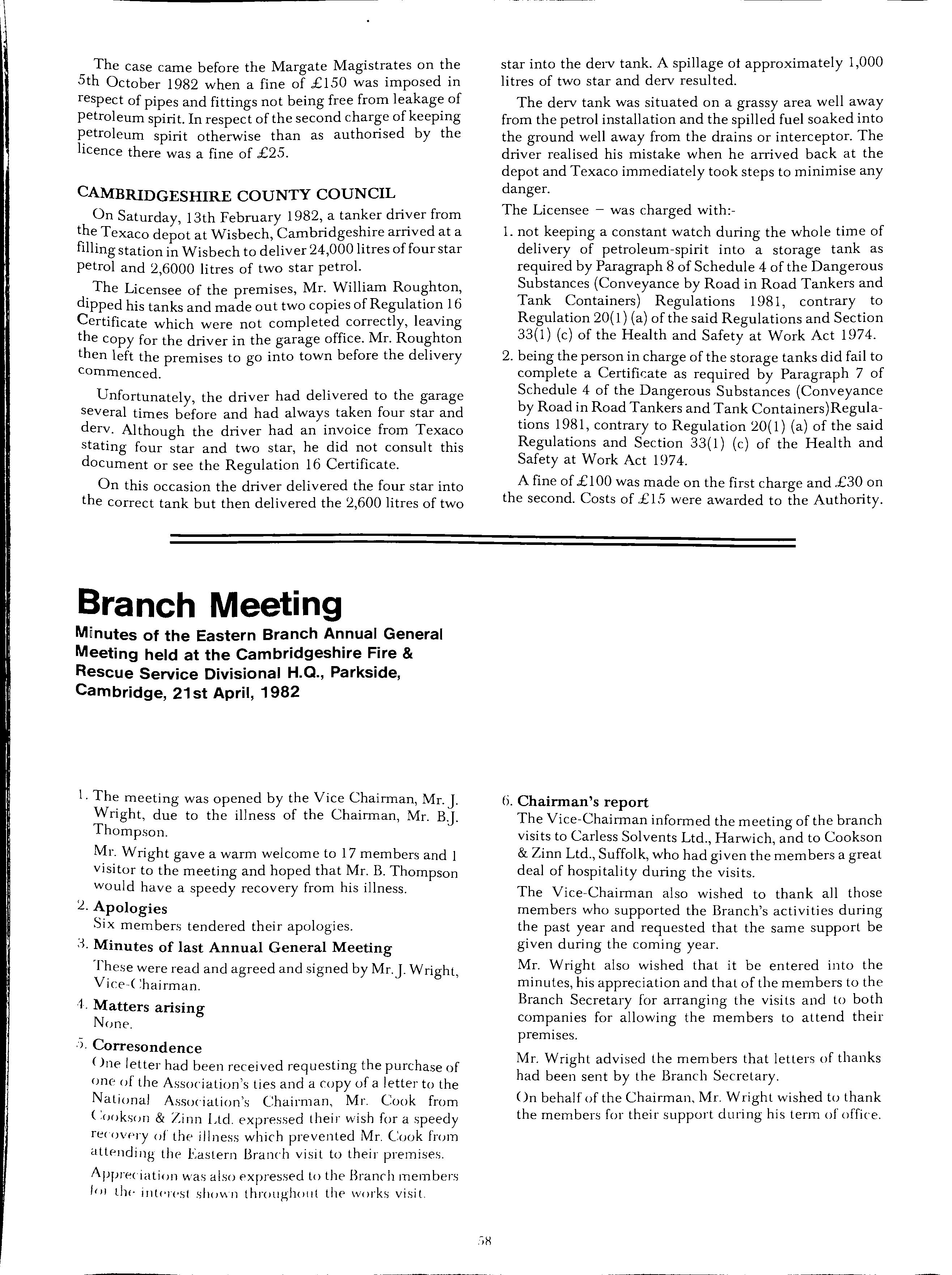
4·.
None.
()ne letter had been received requesting the purchase of one of the Association's ties and a copy of a letter to the National Association's Chairman, Mr. Cook from Cookson & Zinn Ltd. expressed their wish for a speedy recovery of the illness which prevented Mr. Cook from attending the Eastern Branch visit to their premises. Appreciatioll was also expressed to the Branch members ,,,, till' int('rpst shown throughout the works visit.
The Vice-Chairman informed the meeting of the branch visits to Carless Solvents Ltd., Harwich, and to Cookson & Zinn Ltd., Suffolk, who had given the members a great deal of hospitality during the visits.
The Vice-Chairman also wished to thank all those members who supported the Branch's activities during the past year and requested that the same support be given during the coming year.
Mr. Wright also wished that it be entered into the minutes, his appreciation and that of the members to the Branch Secretary for arranging the visits and to both companies for allowing the members to attend their premises.
Mr. Wright advised the members that letters of thanks had been sent by the Branch Secretary.
On behalf of the Chairman, Mr. W right wished to thank the members for their support during his term of office.
Mr. B. D. Taylor thanked the Vice-Chainnan for the vote of thanks in respect of the visi ts and endorsed the request for members to support the Branch during the following year.
Mr. Taylor infonned the members present that he would like to thank the previous Branch Secretary, Mr. E. Brown, for the work he had done for the Branch during his past years of office.
The Branch Secretary advised the members that he thought that visits to manufacturers can be to the advantage of both sides in creating a useful basis of communication and to further the aims of the Association. The Secretary again reiterated the call from past branch officers that if any member had any suggestions for visits or meetings to advise him accordingly.
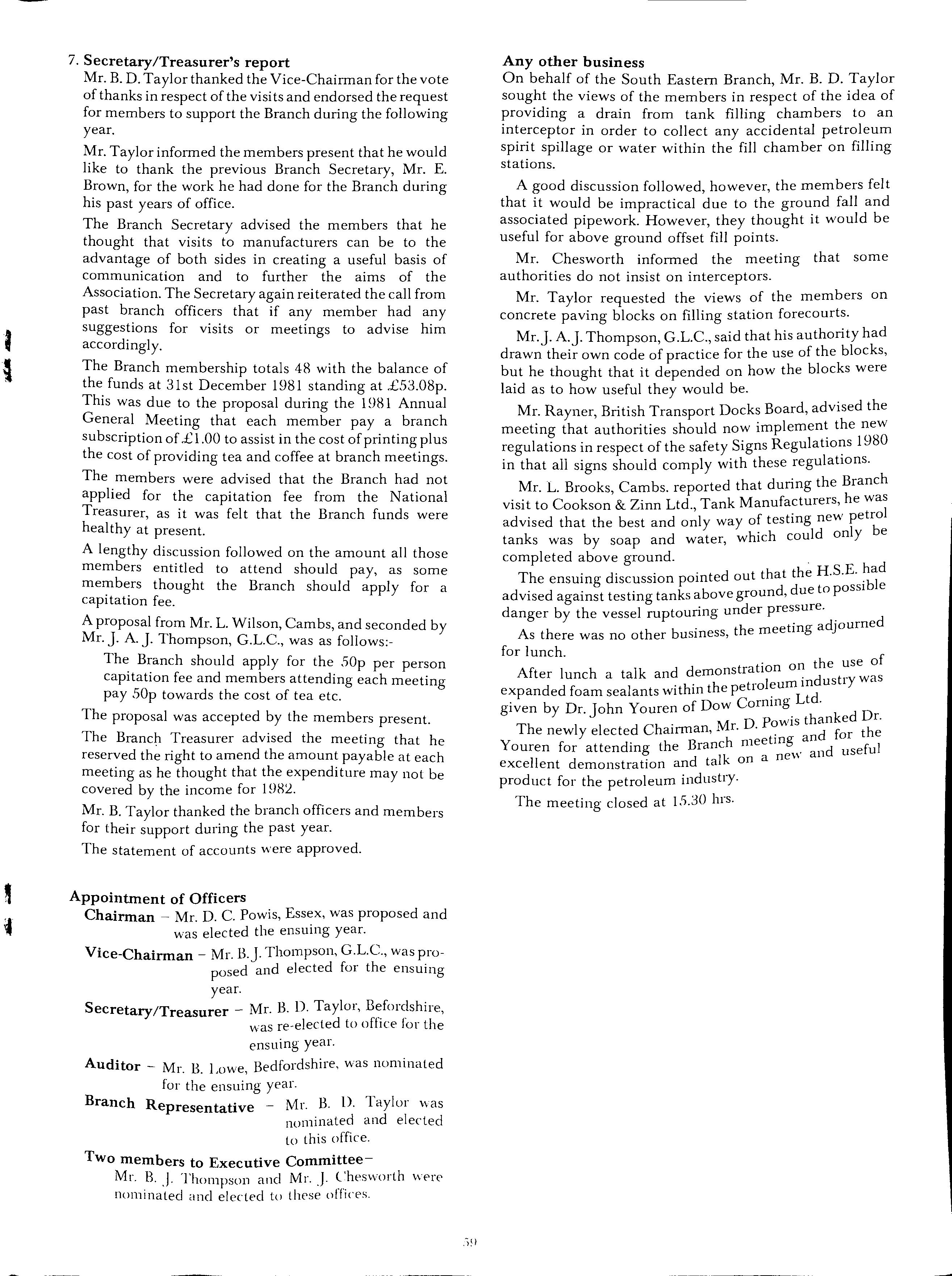
The Branch membership totals 48 with the balance of the funds at 31st December 1981 standing at £53.08p. This was due to the proposal during the 1981 Annual General Meeting that each member pay a branch subscription of £ 1.00 to assist in the cost of printing plus the cost of providing tea and coffee at branch meetings.
The members were advised that the Branch had not applied for the capitation fee from the National Treasurer, as it was felt that the Branch funds were healthy at present.
A lengthy discussion followed on the amount all those members entitled to attend should pay, as some members thought the Branch should apply for a capitation fee.
A proposal from Mr. L. Wilson, Cambs, and seconded by Mr.]. A.]. Thompson, G.L.c., was as follows:-
The Branch should apply for the 50p per person capitation fee and members attending each meeting pay 50p towards the cost of tea etc.
The proposal was accepted by the members present. The Branch Treasurer advised the meeting that he reserved the right to amend the amount payable at each meeting as he thought that the expenditure may not be covered by the income for 198:2.
Mr. B. Taylor thanked the branch officers and members for their support during the past year. The statement of accounts were approved.
Chairman Mr. D. C. Powis, Essex, was proposed and was elected the ensuing year.
Vice-Chairman Mr. B.]. Thompson, G.L.c., was proposed and elected for the ensuing year.
Secretary/Treasurer Mr. B. D. Taylor, was re-elected to office for the ensuing year.
Auditor Mr. B. Lowe, Bedfordshire, was nominated for the ensuing year.
Branch Representative Mr. B. D. Taylor was nominated and elected to this office.
Two members to Executive CommitteeMr. B. .J. Thompson and Mr. .J. Chesworth were nominated and elected to these offices.
On behalf of the South Eastern Branch, Mr. B. D. Taylor sought the views of the members in respect of the idea of providing a drain from tank filling chambers to an interceptor in order to collect any accidental petroleum spirit spillage or water within the fill chamber on filling stations.
A good discussion foIl owed, however, the members felt that it would be impractical due to the ground faIl and associated pipework. However, they thought it would be useful for above ground offset fill points.
Mr. Chesworth infonned the meeting that some authorities do not insist on interceptors.
Mr. Taylor requested the views of the members on concrete paving blocks on filling station forecourts.
Mr.]. A.]. Thompson, G.L.c., said that his authority had drawn their own code of practice for the use of the blocks, but he thought that it depended on how the blocks were laid as to how useful they would be.
Mr. Rayner, British Transport Docks Board, advised the meeting that authorities should now the new regulations in respect of the safety Signs 1980 in that all signs should comply with these regulatIOns.
Mr. L. Brooks, Cambs. reported that during the Branch visit to Cookson & Zinn Ltd., Tank Manufacturers, he was f t f g new petrol advised that the best and only way 0 es III tanks was by soap and water, which could only be completed above ground. . d
The ensuing discussion pointed out that the H.S.E. ?bal b d due to pOSSI e advised against testing tanks a ove groun , danger by the vessel ruptouring under pressure. . d
As there was no other business, the meeting adJourne for lunch. f f n on the use 0
After lunch a talk and demonstra dustry was expanded foam sealants within the petro given by Dr. John Youren of Dow Cormng t. k d D . M D Powis than e r.
The newly elected Chalnnan, r. '. and for the Youren for attending the Branch meet!I1g and useful excellent demonstration and talk on a ne" product for the petroleum industry.
The meeting closed at 15.30 hrs.
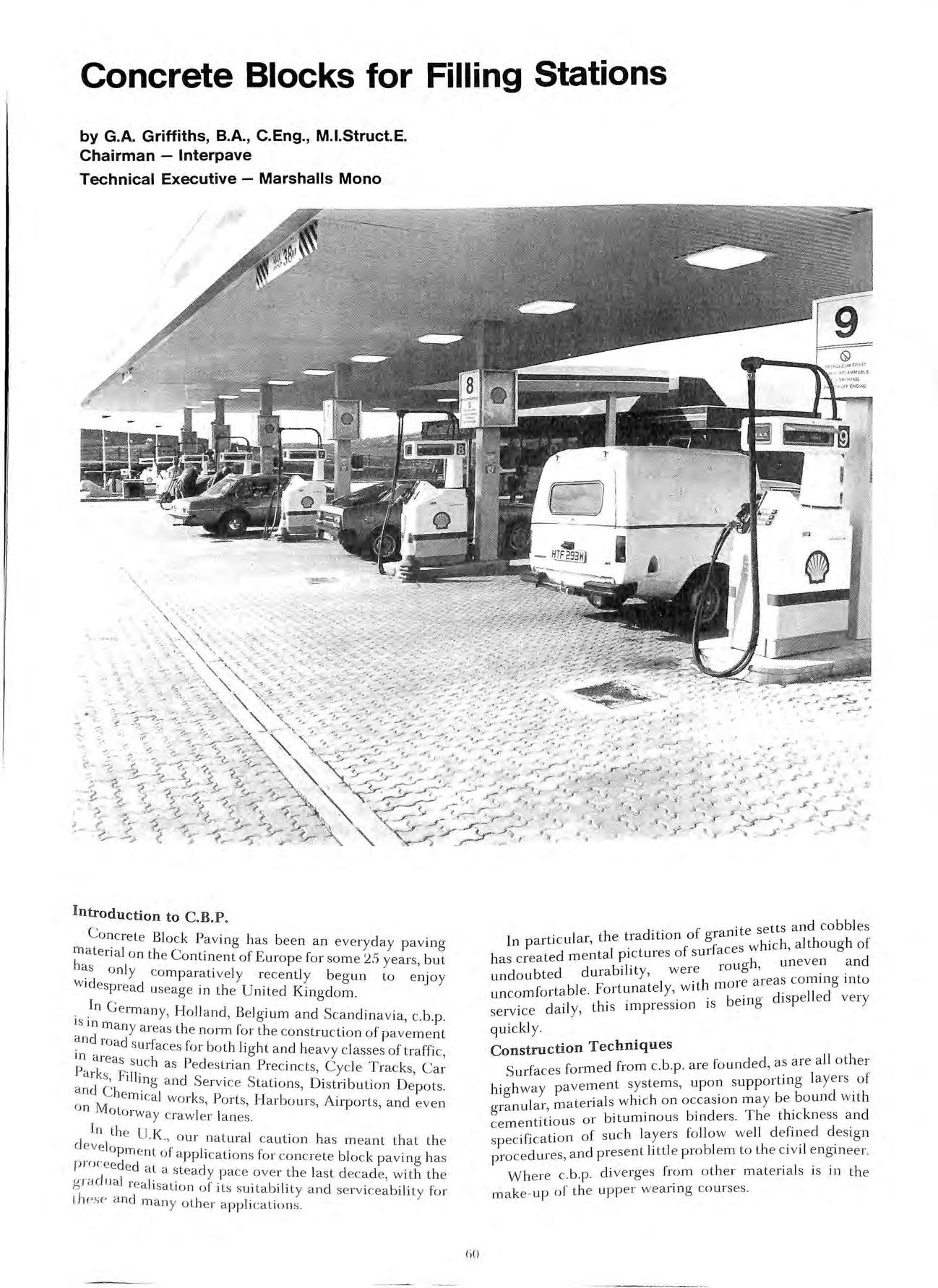 by G.A. Griffiths, B.A., C.Eng., M.I.Struct.E. Chairman - Interpave Technical Executive Marshalls Mono
by G.A. Griffiths, B.A., C.Eng., M.I.Struct.E. Chairman - Interpave Technical Executive Marshalls Mono
Co ncret e Block Paving has been an eve ryday pav in g m h ate nal on th e Continent of Europe for so me 2.') years b u t as 0 I· ' wid Y co mparative ly rece n t ly beg un to enjoy es plead use age In th e Un i te d Kingdom.
In Ge rman y, Hol la nd , Be lg-ium and Scandinav ia c b p IS III m ' a nd any areas th e norm for th e co nstru ct ion of p ave ment surfaces fo r both li ght and heavy c lasse s of traffic In a l e as s h p d" ' P k lIC as e est nan PreCincts Cycle Tracks C ala r s F II' " and C l I Ill g an d Se r vice S t a ti o ns, Distribution Depots. On M wo rk s, Ports, Harbours, Airports, and ev en OtOI way craw ler la nes.
In the U K d e I " , OUI nat ur a l ca u tIO n h as m ea nt lhat the _ ve op m ent of app li catio ns for co ncrete b lock paving· has p l o ceed ed ' . . _ ITa du al _ a t a steady pac e over the la st d ecad e , with th e . . l ea ll satIO Il of It s suitabi lit y a nd se rv iceabilit y for llPSP and man y ot he r app li cat i n s
d · f ' a nit e setts a nd cobbles
I n particu lar t h e tra ItIOn 0 g r h It h h f '. f w hi c a oug 0 h as created m e n ta l p ictures o f SUi aces, d b ' I ' ro u o- h u neven an undoubte d dura Il ty, were to " I re areas comll1g ll1to un co m for tab le . Fortunate ly, Wit 1 mo . ( d' I1 d _ .' " be Il1 g- Isp e ever y se rvi ce da il y, thi S ImpressIOn IS q uick ly.
Construction Technique s
Surfaces formed from c. b.p are founded , are a ll oth e r h ighwa y pav e ment sys te m s, upon suppo r tJI1g layers. o f granu lar, mate ria ls wh ic h on oc.casIOn may be bound Wit h cementit iou s o r bit u mll10 us b11lder s. T h e t hickn ess an d s ec ificat ion of such layers foll ow we ll defin e d d es ign a nd present litt le prob le m to t he c ivil engineer.
Where c .b.p. di verges from other m ateria ls is in the make up o f th e upp er we a ring cou rses.
The upper surface is made up of concrete blocks which are of such a size that they can be picked up in one hand. They may be "rectangular" or "shaped", and are laid closely together in a herringbone or similar pattern. They are supported by a 50mm layer of compacted sand, and this sand penetrates the gap between the blocks from beneath, this gap being typically 3 4mm. The gap is further sealed during the laying process by additional sand which is spread over the surface.
The entire surface is vibrated into position by the use of small plate compactors, and the result is a wearing course which is capable of carrying heavy loads immediately after completion, and whose permeability to rainwater or spilled liquids is very low.
The blocks provided for most classes of loading have thicknesses of between 60 and 80mm, and when they are locked together by the sand in the joints, are capable of carrying and distributing onto the underlying materials the heaviest road vehicles and industrial loadings.
The block surface needs to be laid to falls to dispose of surface water to drains in the same way as for most other since the top sand in the joints rapidly combines With detritus and road traffic debris to forn1 an impermeable construction.
Since the introduction of concrete block paving to the U.K. a decade ago, considerable experience has been built up on the performance levels achievable, initially in pedestrian and lightly trafficked areas, but latterly in heavy duty applications in industrial areas, container terminals, in docks and in airports; Indeed some of the latest developments include the installation of c.b.p. at the end of Airport Runways, and on Aircraft holding areas.
Drawing on continental experience, many filling station forecourts have been constructed over the past ten years, with perhaps the most noteworthy example being that of the Blue Boar service station at Watford Gap on the Ml where the paving has been in service on both north bound and south bound forecourts for about eight years and has successful! y carried many millions of vehicles, both private and commercial.
Following the experience gained in installations such as these, many of the major oil companies have considered the use of c b.p. as part of their forecourt rejuventaion schemes, and in order to present a "house style", and as a result, a very large proportion of filling station forecouts currently under construction incorporate areas of c.b.p takmg advantage of its rapid construction, attractive appearance and easy access to buried services.
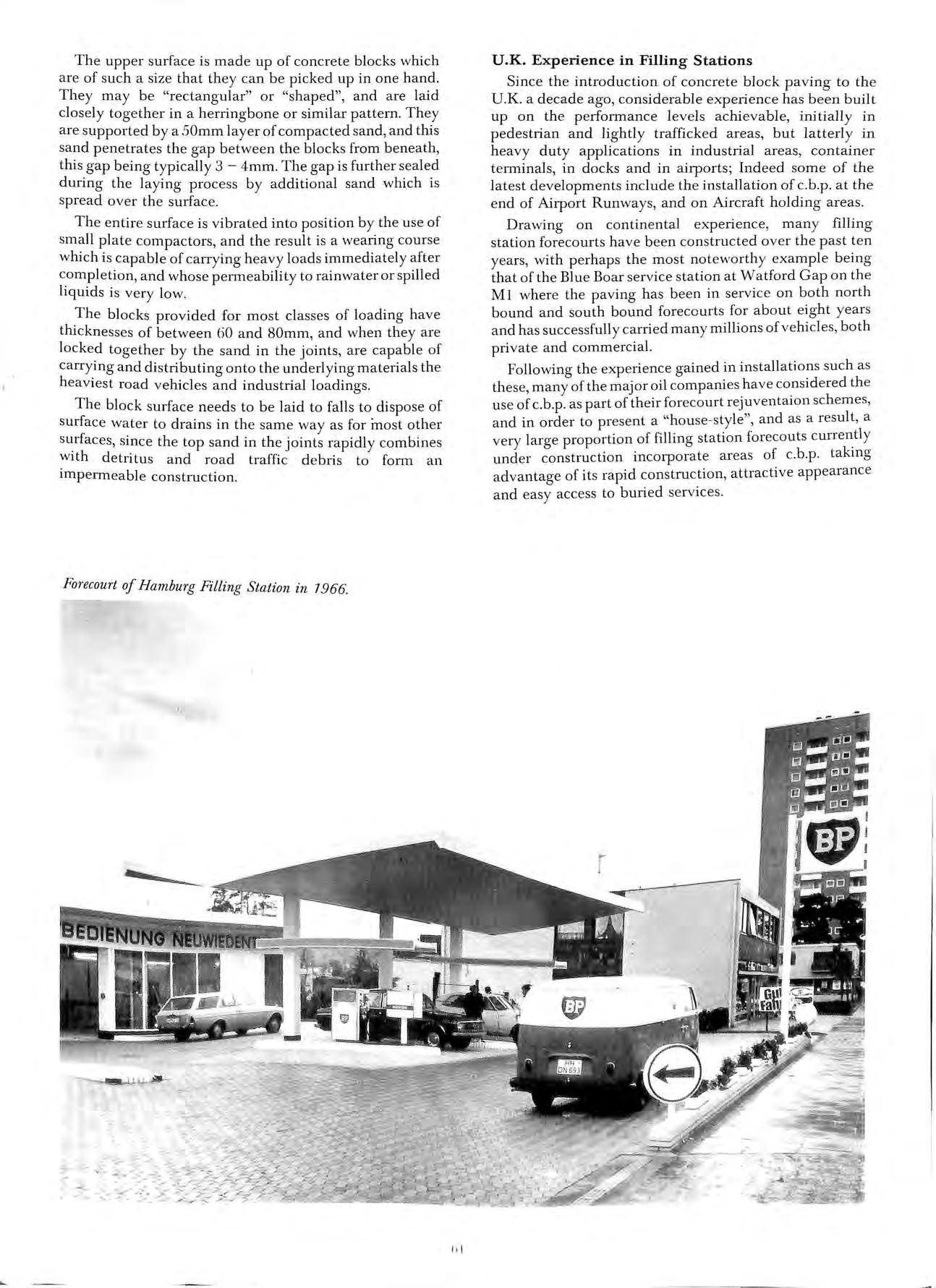
As permission has been sought from Petroleum officers to incorporate this material in forecourt construction, particularly in urban areas, questions of permeability and vapour penetration have usually been prominent in the discussions, particularly where architectural considerations sought the use of the material around pump islands and filling points.
Recently, in an attempt to quantify the permeability of concrete block paving petrol station forecourts, a joint investigation was carried out by the Fire Prevention Branch of the G.L.c., Esso Petroleum Co. Ltd., and "lnterpave", the association of c.b.p. manufacturers. In this investigation, evidence was sought of petroleum spirit within the sand bedding layer at a series of Filling Stations on the southern outskirts of the G.L.c. area.
At one station, a history of leakage from service pipes was reflected in Explosimeter readings of 70 u,l,) to 55% of LEL taken by lifting one block and stirring and "sniffing" the laying sand thus revealed.
In this case, the blocks were 100mm thick and had performed satisfactorily in a rural location for some eight years.
At more typical stations with service histories cif from 1 to 6 years, wi th block thicknesses of 80mm, LEL's of from 0 to 20 % were measured immediately alongside pump islands, with a good correlation between pump useage and petrol penetration In one isolated instance, evidence of old petrol discolouration was seen with a local LEL of 30%.
The evidence which this investigation produced was felt to be somewhat at odds with previous reports related to Continental experience, and therefore further invesitgations were carried out on a number of in-situ concrete forecourts in the same general area which, it was assumed would give some data related to impermeable construction. This investigation produced LEL's of from 211<% to 15%, and these levels were measured in the underlying construction materials in the areas of flexural cracks in the in -si tu concrete, and in the vicinity of joints which appeared to be completely filled with bitumastic matenal in good condition.
In one instance , an appreCiable LEL reading was obtained within the depth of concrete in an apparently undamaged area
ConS ideration of these results may lead to the con I . le C USlon that Concrete Block Paving is not significantly h ss Imp ermeable than in -si tu concrete forecourts which ave for c many years been an acceptable form of onstruction f 'f" P or certl IcatlOn: In any event, the G.L.c. Fire reventlOn B· h b . p lanc su sequently Issued a letter under the etroleum (C I·d ') , w' ll' onso I atlOn Ac t 1928 mdlcatll1g then t tngne ss t h 80 0 accept t e use of Concrete Block Paving mm thick sub' t t· , la in '. Jec 0 meetmg normal manufactunng and h yg speCificatIOns : Many other authorities in the u.K. ave also tak "1 b " en a stmt ar view, and c. b.p. forecourts seem to e see n dail ['11" over h y on I mg statIOn construc tIOn proje cts all t . e COuntry .
No r is the ir use co nfined to filling stations for their c onSiderab le Id ' attrac t' oa carry ing capabili ty coup led with . live appearance and durability have promoted their us e Il1 t le load' b f , lI1 g ays 0 several OI l co mpany distribution depots aro und t he l.J. K.
C.b.p.'s ability to withstand spillage of hydraulic fluids and other chemicals has made it a very valuable material for use in areas such as Container Terminals, where the Handling equipment seems to deposit large volumes of such fluids at regular intervals. The additional advantages of access to services has added to the products' versatility, and ill. addition the resistence to abrasion has encouraged their use in for example bulk ore handling installations, and scrap loading wh\l.rves.
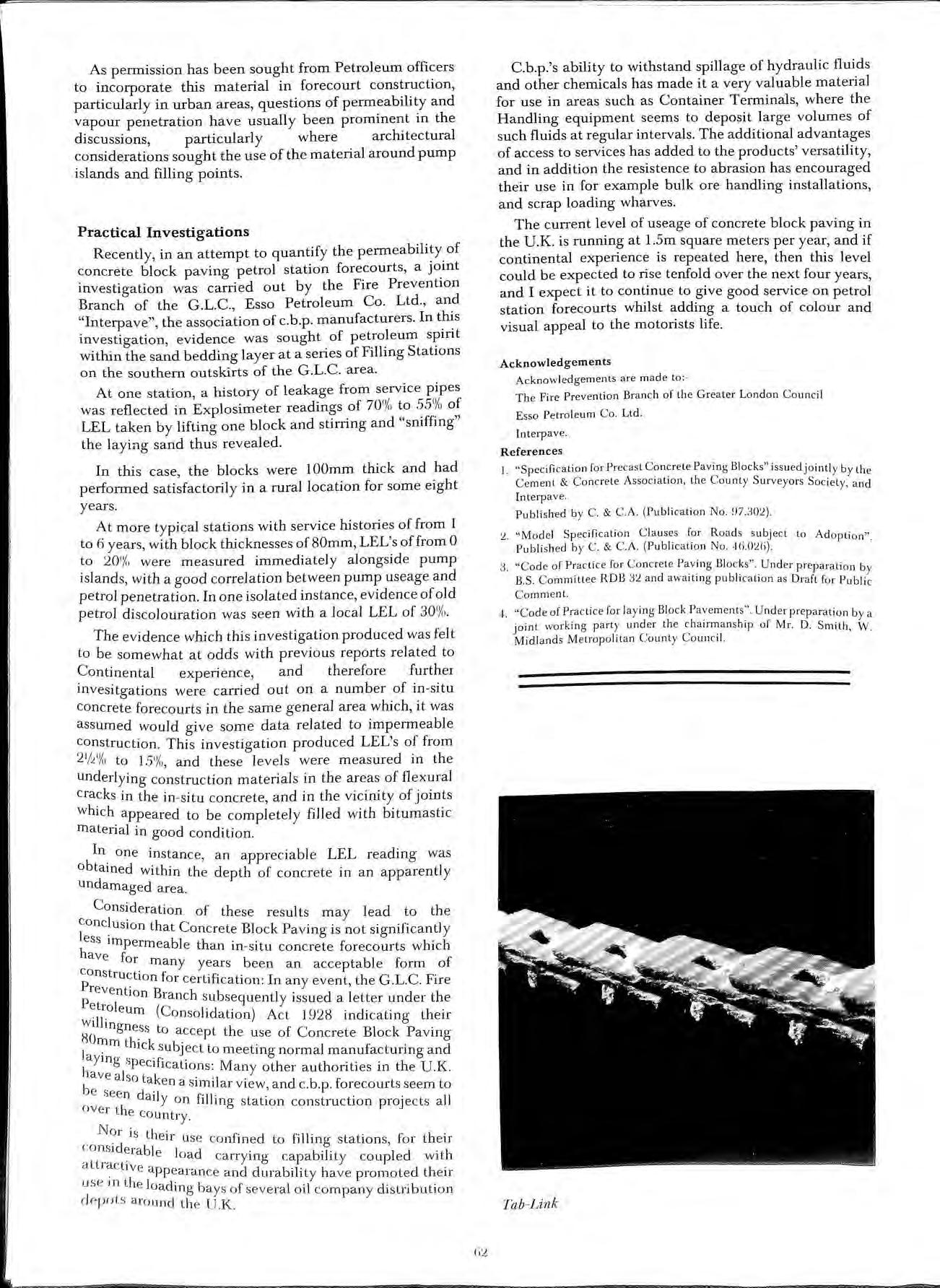
The current level of useage of concrete block paving in the U.K. is running at 1.5m square meters per year, and if continental experience is repeated here, then this level could be expected to rise tenfold over the next four years, and I expect it to continue to give good service on petrol station forecourts whilst adding a touch of colour and visual appeal to the motorists life.
Acknowledgements are made to: The Fire Prevention Branch of the Greater London Council Esso Petroleum Co. Ltd.
Interpave, References
I. "Specification for Precast Concrete Blocks" issued jOintl y by the Cement & Concrete ASSOCIatIon, th e County Surveyors SOCiety, and Interpa ve Publi shed by C. & C.A. (Publication No
"Model Specification Clauses for Roads subject to Adoption". Published by C. & C.A. (Publication No. 4/d):26),
3 "Code of Practice for Concrete Paving Blocks". Under preparation b , B.S. Co mmittee ROB 3:! and awaiting publication as Draft for Comment.
4. " Co de of Prac ti ce for la ying Block Pavements:'. Under preparation by a joint workll1g part y under th e chaIrmanshIp of Mr. D. Smith, W. Midlands Me trop o litan County Council.
ARTICLE 2
Brammer Trasmissions Limited.
The article printed in Volume 20 No. 3 stated the si tuation in the earl y part of 1982 on the use of the NU TLink (studded) and TAB-Link (non-studded) belts on forecourt dispensers. This article will up date the further developments that have taken place.
The editorial comment stated correctly that some Licencing Authorities had expressed concern on the use of a belt with steel studs in the presence of aluminium pulleys. Their opinion was that should the studs rust and then come into contact with the aluminium then a spark hazard could exist. It was suggested that contact be made with BASEEFA to determine the extent of this potential hazard, and in addition to ensure that a static risk did not exist with either type of belt.
BASEEFA passed on the test requirements to the Heal th & Safety Executive who carried out testings on both the above mentioned areas replying to Brammer Transmissions Limited and other interested parties on May 20th, 1982. Their opinion was that the likelihood of studs rusting and then coming into contact with the aluminium pulleys was extremely remote and not a serious hazard, and in addition their opinion was expressed that neither of the bel ts would present an electro-static risk.
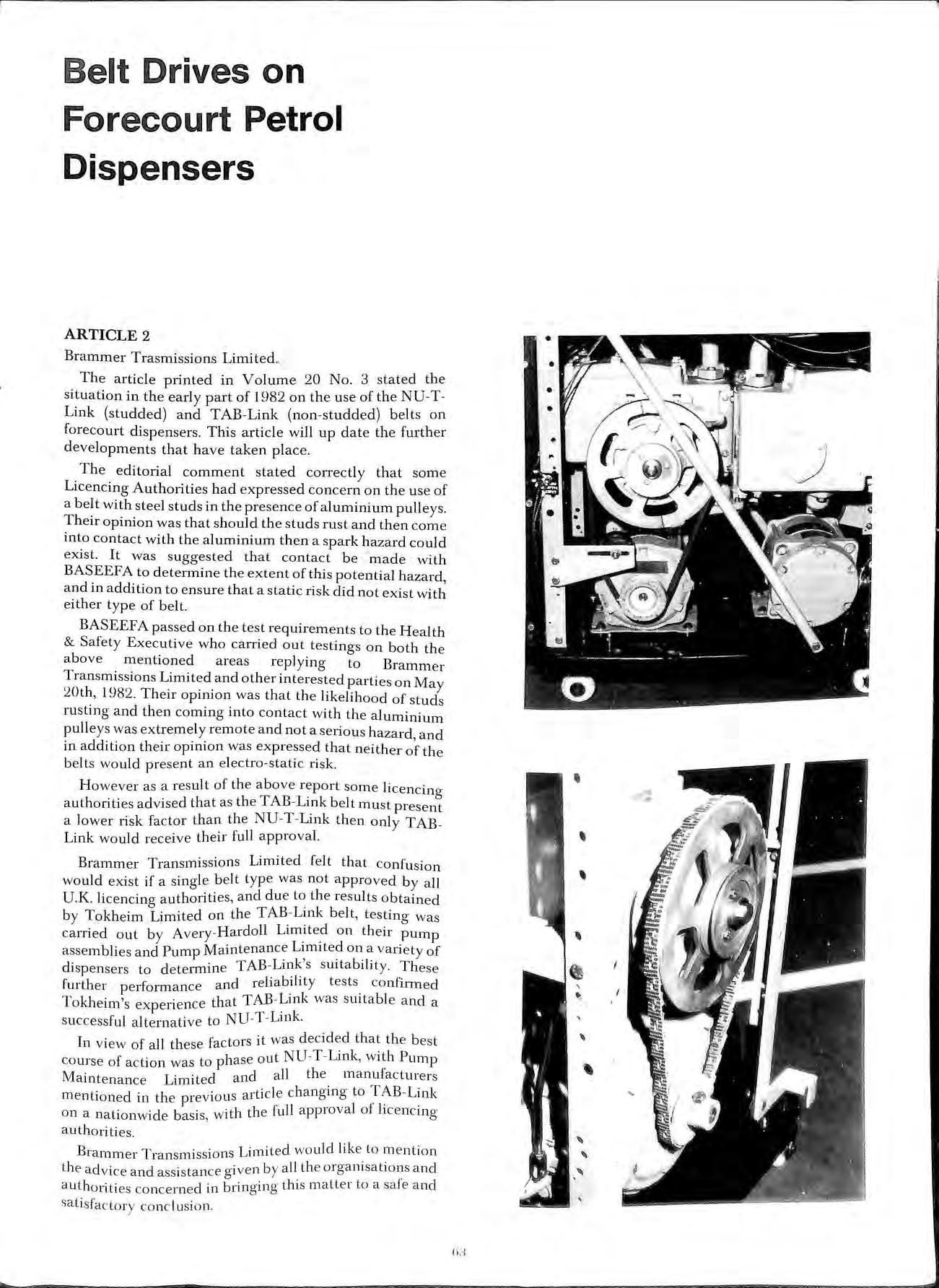
However as a resul t of the above report some licenCing authorities advised that as the T AB Lmk belt must present a lower risk factor than the NU-T Link then only TABLink would receive their full approval.
Brammer Transmissions Limited felt that confusion would exist if a single belt type was not approved by all UK. licenCing authorities, and due to the results obtained by Tokheim Limited on the TAB Lmk belt, testing was carried out by Avery Hardoll LImIted on their pump assemblies and Pump on a vanety of dispensers to determine T AB Lmk s sUI tabIlI ty. These further perfom1ance and reliabIlIty tests. conhrn1ed Tokheim's experience that TAB Lmk was SUItable and a successful alternative to NU T -Lmk.
In view of all these factors it was decided that the best co · f t" t phase out NU -T- Link, with Pump
LIlse 0 ac Ion was 0 Ma " t L" "t d and all the manufacturers 1!1 enance Iml e , mentioned in the pre viouS article changing to TAB- Link 011 a t " "d b " wl"th the full approval of hcencll1g" nalonwl e aSIS, authori ties"
Brammer Transmissions Limited wo uld like to mention the ad vice and assistance o"iv en b y all th e organisations and authori ties co nce rn e d in bringing this matte r to a safe and sat iSfactory conc I usi o n"
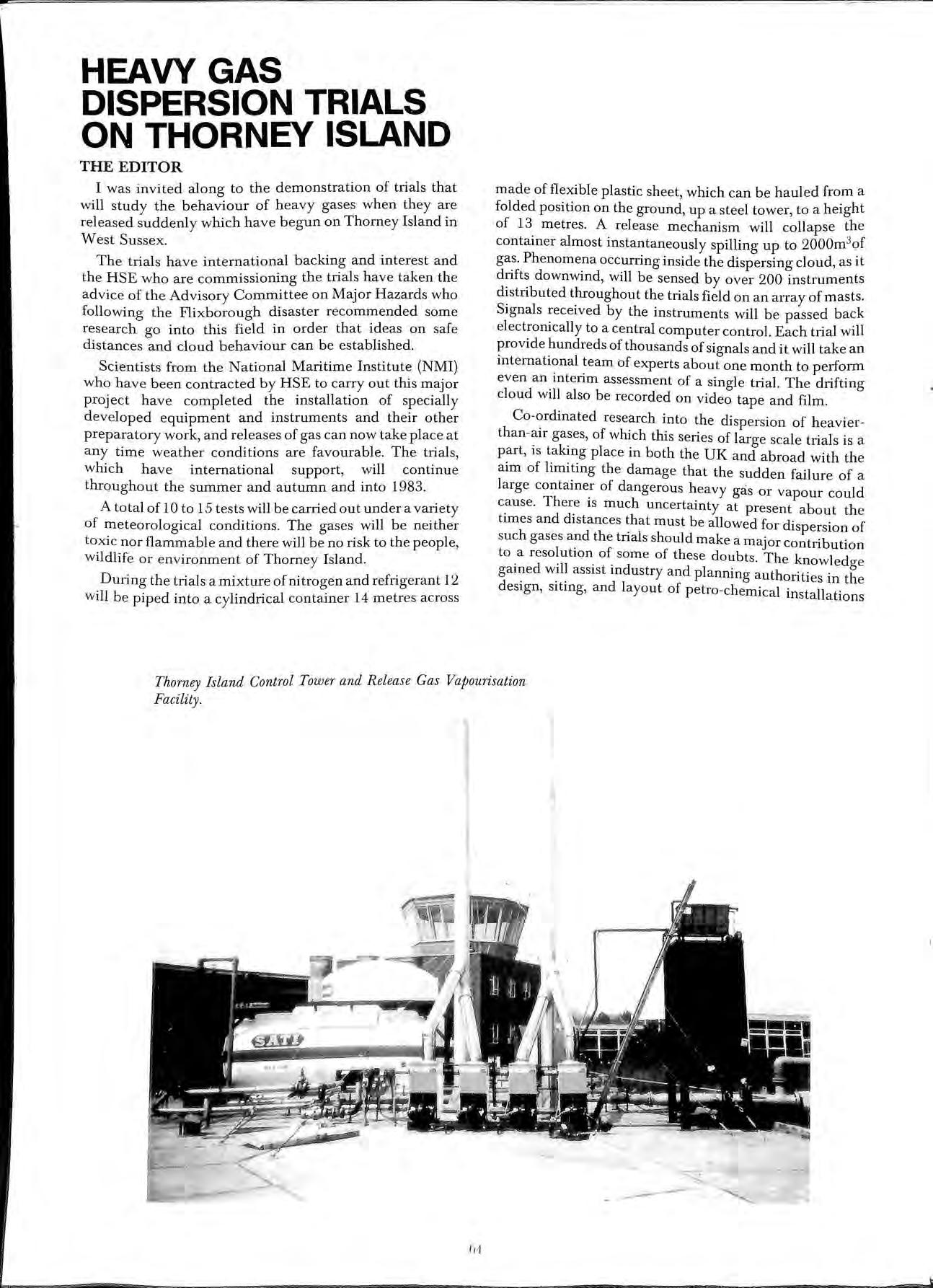 THE EDITOR
THE EDITOR
I was invited along to the demonstration of trials that will study the behaviour of heavy gases when they are released suddenly which have begun on Thorney Island in West Sussex.
The trials have international backing and interest and the HSE who are commissioning the trials have taken the advice of the Advisory Committee on Major Hazards who following the F1ixborough disaster recommended some research go into this field in order that ideas on safe distances and cloud behaviour can be established
Scientists from the National Maritime Institute (NMI) who have been contracted by HSE to carry out this major project have completed the installation of specially developed equipment and instruments and their other preparatory work, and releases of gas can now take place at any time weather conditions are favourable. The trials, which have international support, will continue thrQughout the summer and autumn and into 1983.
A total of 10 to 15 tests will be carried out under a variety of meteorological conditions. The gases will be neither toxic nor flammable and there will be no risk to the people, wildlife or environment of Thorney Island.
DUring the trials a mixture of ni trogen and refrigerant 12 will be piped into a cylindrical container 14 metres across
made of flexible plastic sheet, which can be hauled from a folded position on the ground, up a steel tower, to a height of 13 metres. A release mechanism will collapse the container almost instantaneously spilling up to 2000m30f gas. Phenomena occurring inside the dispersing cloud, as it downwind, will be sensed by over 200 instruments the trials field on an array of masts. SIgnals by the instruments will be passed back electromcally to a central computer control. Each trial will provide hundreds of thousands of signals and it will take an international of experts about one month to perform even an. mtenm assessment of a single trial. The drifting cloud wIll also be recorded on video tape and film. research into the dispersion of heavierof which this series of large scale trials is a part, IS taking place in both the UK and abroad with the aim of limiting the damage that the sudden failure of a large containe.r of dangerous heavy gas or vapour could cause. There IS much uncertainty at present about the times and distances that must be allowed for d· . f . IspersIOn 0 such gases the tnals should make a major contribution to a resolutIOn of some of these doubts. The kid . d ·11 . . d nowe ge game Wl aSSIst m us try and planning auth ·t· . h on Ies m t e deSIgn, SIting, and layout of petro-chemical installations
Thorney Island Control Tower and Release Gas Vapourisation Facility. 1 .,

